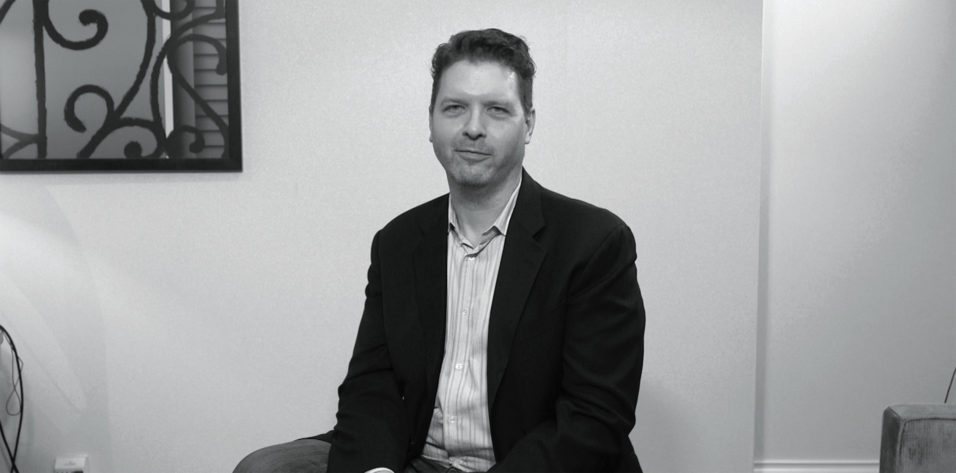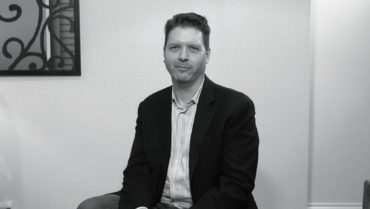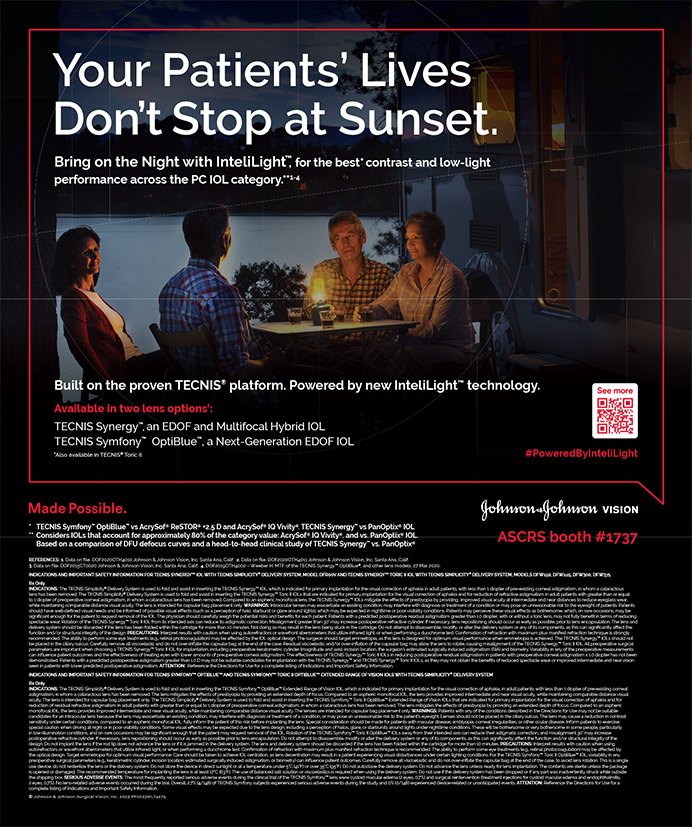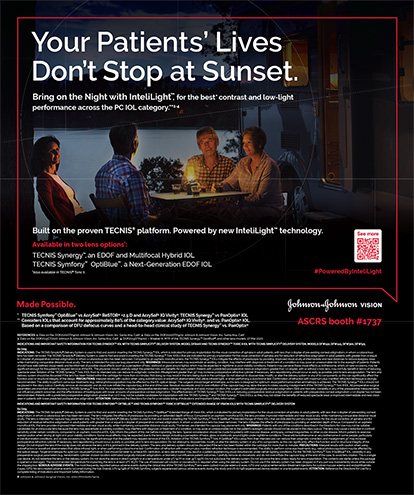Of the many things Dr. Jones is known for, perhaps the most graphic is his surgical videos showcasing a number of vital techniques for cataract surgery. Dr. Jones’ interests include advanced cataract techniques, new IOL technologies, and prosthetic devices to assist complicated or unusual surgeries. In this interview, he talks about the value of reviewing one’s surgical missteps on video, the importance of sharing experiences, and how his 3-year-old daughter speaks better Chinese than he.
Interviewed by Laura Straub, CRST/CRST Europe Editor-in-Chief

BMC: Who or what drew you to ophthalmology?
Jason J. Jones, MD: My father is an ophthalmologist, and that was a large part of my inspiration for going into the field. He demonstrated what it’s like to live the lifestyle that we live as surgeons. Growing up, I got a lot of exposure to ophthalmology, not just in his office and with his patients, but in traveling, going to meetings, and visiting other doctors’ offices. Visiting other doctors has been lost nowadays because we have so much better electronic communication, such as through sharing videos. But those were important solidifying elements in my decision to become an ophthalmologist.
BMC: When you visited other practices with your father, what was his reasoning for going and also for bringing you along?
Jones: I was quite young when I first started accompanying him on these visits, and it continued through high school and even when I was in college. When we took family trips, we would decide on a location, and he would say, “I met this guy at a meeting this past year, and he’s just down the road from where we’ll be staying. I’m going to see if I can visit him.”
I think part of the benefit for him was to see the lay of the land in that office. This was an early time in terms of ambulatory surgery centers (ASCs). People were building ASCs in the mid to late 1980s, and the ASC I work in now was opened in 1987—a fairly early one.
There was also an element of spontaneity because you didn’t know what you would learn, so he always kept an open mind toward seeing what’s happening at that location, with that doctor, and how things work. There’s less of that nowadays. We’re interested in others’ surgical techniques, and you can see such good video that a site visit doesn’t have the same level of importance. So we probably lose some of those serendipitous findings that we would get in the past.
BMC: You went to undergraduate and medical school on the East Coast, and then did your residency in Utah, and now you’re practicing in the Midwest. Has experiencing life and practicing medicine across various parts of the United States helped shape you as a physician?
Jones: Yes, certainly. There are differences of lifestyle in all of these locations, and people interact differently with each other. I will never forget, when I was interested in leaving New York City to go to the University of Utah, and I asked one of the residents at my medical center what he’d heard about the University of Utah, he told me he really didn’t know much about it other than it was in Utah.
I kept an open mind, and I got to experience different elements of lifestyles living in a very urban environment, and then a more rural, suburban type of environment in the Salt Lake City area. And then I came back to my hometown. Growing up, I didn’t have aspirations of coming back here, but it was an opportunity for me. And that opportunity was and is still good, in terms of my practice and the lifestyle. I really appreciate what it has offered me, both professionally and personally.
BMC: When you returned to the Midwest, you joined your father’s practice, correct?
Jones: Yes. My dad was still practicing for a few years, and we were concurrent. He still likes to poke his head in the door and see what’s going on occasionally. The transition between us was interesting for me. We have sometimes hearty folks here in the Midwest, and many of the patients in this area are farmers and very salt-of-the-earth. There’s a lot of Northern European ancestry as well. My father and I would be in the examination lanes together, and if he saw a patient who seemed challenging for some reason—pseudoexfoliation, a small pupil, cornea guttata, a dense cataract, or if the patient was wheelchair-bound or monocular, or all of the above—he would talk with and examine the patient, and then he’d say, “My son will be in here in a few minutes, and he’ll take a look at you. He’ll be doing your surgery.”
Essentially, for the first 2 or 3 years, I got all of the difficult cases. I was well-equipped due to my experience from residency, but I also had to evolve from there. That was a good challenge. Now I take care of all of the patients, and I still find plenty of challenges. But that was something that really tested my abilities at the early stage of my career.
BMC: What are your biggest passions inside your profession?
Jones: Moving the ball forward, whatever that entails, in terms of technology, and understanding a new technique better or maybe revisiting old techniques. For example, I still find the nuances of hydrodissection interesting, and I continually try to refine that process, to make it more dependable, and more consistent.
Video can play a role in terms of understanding those sorts of things. This is why I love video: It’s an excellent means of communication, especially communicating things that you cannot describe verbally.
Moving the ball forward also applies to participating in clinical trials. I brought clinical trial participation into this practice after I was here for several years. Working with industry people, different companies, and different technologies helps to push that boundary forward.
It all goes back to not accepting what we have as good enough. Although it’s also valid to recognize that what we have already is quite good—excellent, really. But there is still room to make cataract surgery and IOL technology better. We’re in a bit of a renaissance now, in that phaco and IOL technologies have really been pushing forward. It’s exciting to see. I did not foresee that I’d be changing my practices and evolving as quickly as we have.
BMC: With regard to IOL and phaco technologies, what are some of the things that you are currently excited about?
Jones: I’ve used a variety of different technologies. I still like the phaco ultrasound technology, and I think that there’s room to grow. It’s become a much more refined technology in many ways, including ways that are sometimes surprising. But, if the attitude is to grow this space and push our boundaries forward, I think something as simple and as basic as the »miLoop (Iantech) can offer a particular advantage in selected cases, and that’s exciting. I think it has great promise for advanced cataracts, in particular—patients who might not be good candidates for phaco because of the density of the cataract. This would allow us to manually extract the lens through a relatively small scleral tunnel incision. It could also be a step forward in manual small-incision cataract surgery, performed often in developing nations.
I have also used the femtosecond laser for cataract surgery. That experience taught me a lot, and I am still fascinated by that technology, but I have moved away from it. My main reason was that I found I was still doing a significant portion of the cataract surgery procedure with a traditional approach, and the combination of the technologies was an expensive way of doing surgery. This was true not only in terms of financial outlay for the practice and the patient, but also in terms of time efficiency.
I think the other capsulotomy cutting technologies, the »Zepto Precision Pulse Capsulotomy device (Mynosys), and the »CapsuLaser (CapsuLaser), are interesting. I have tried Zepto, and I’m going to do more work with it, but the financial barrier to these technologies being well accepted is quite high.
Can these devices perform better than we can manually? The argument is that maybe they can, but they have to prove to be worth the cost, and I’m not sure they’re there yet. It’s good to be skeptical. I think the jury’s still out on some of these things, but let’s see where they take us. The market will dictate whether they really have a place.
BMC: You make a lot of surgical videos, and you were among the first to dive into concentrating on surgical videos. What were and are your motivations to create videos?
Jones: Actually, the person I think of as the pioneer of surgical video is Howard V. Gimbel, MD, MPH, FRCSC, AOE, FACS. And there are many others: I. Howard Fine, MD, is another excellent resource in terms of early surgical video.
Back in the day, I remember my father watching surgical videos. That was an inspiration to me that carried forward to my residency with Alan S. Crandall, MD. The entire surgical experience included not just doing the surgery, but also watching the video afterward so you could understand better what happened, especially if there was a complication.
I still watch my surgery cases. I record essentially every one of them, but I don’t keep them as part of the patient record. Rather, I use it as a learning tool for myself. It’s a considerable investment of time and money to create and watch them, but I find it cathartic and somewhat relaxing.
There are specific surgeries that were watershed moments for me that actually changed the way I did surgery. The video helped me to not just recall the event, but to have a window into what the experience was like—reliving it, but in a more dispassionate manner. I can look at that video time and again if I need to understand it better. Video doesn’t tell you everything about what happened, especially if things go wrong, but it can certainly help you understand. I look at it as an investment in myself.
BMC: You have quite a few elegant and complex surgical cases that you’ve posted to Eyetube and YouTube. Have you heard stories about how one of your videos has helped somebody during a tough case?
Jones: I certainly have. I’ve published some videos on posterior capsulorrhexis. We all break a posterior capsule at times. A person came up to me at a meeting and said, “I had that happen, and then I remembered your videos, and I created a posterior capsulorrhexis and put the lens in. There was a company rep there in the OR with me, and he couldn’t believe I did that.”
The reality is, posterior capsulorrhexis is an old technique. It’s just that there were not a lot of videos available. When I first wanted to do posterior capsulorrhexis, I hunted far and wide for information and especially videos. I found little information and very few videos. There are some great articles in which people talk about their techniques, but language is sometimes limiting. The moving image can be so much more understandable.
Sharing experiences makes a big difference to me because it allows other people to pick up those ideas. This is how I’ve learned some of my techniques. Surgeons who publish their videos on Eyetube or YouTube can be fantastic resources to understand how others confronted a problem, how they accomplished a successful outcome.
I still search for videos all the time and pull up Eyetube every day or so to see if there is a new posting. I don’t just search cataract and IOL, I watch retina, for example, because I have patients who need retina care as well. Understanding how those issues can be approached helps me talk to patients about what to expect when I need to refer them.
Another thing that’s interesting is the number of patients from around the world who have contacted me. I’ve had patients call me from Australia, Germany, England, and all across the United States saying they saw a video on YouTube and they want to know if they can come to my office. I’m flattered that people want to come and potentially be a patient of mine, but I find it more satisfying and appropriate for most of these patients to find an excellent surgeon in their own area, and usually that’s what I encourage them to do. I help direct them toward someone with the expertise to handle the problem they’ve described.
BMC: What is one thing you love about your home life, and one thing that you wish you could change?
Jones: My family is my bedrock. My wife is a fantastic partner in life; she’s also an ophthalmologist in our office. We have two lovely kids. Having them as a part of my life is a counterbalance to the craziness of practice, and a respite from the overwhelming activity that can be a part of a career.
As far as what I would change, I’d like to get more time for my personal life. Finding adequate time to spend with the people you love is challenging when other things can be so consuming. I still want to live up to the challenge of what my practice brings to me, but as I’ve gotten older, I want to give up less of my personal life if I can. Trying to strike that balance is a challenge that we all face.
For me, practice is beyond just seeing the next patient and doing the next surgery. It’s sharing with other people what I do surgically through videos, books, and articles. That’s something I learned early on: Having multiple things in your life is reassuring because not everything is going to work well in every facet of your life. If you have more things in your life, there’s a better chance that some of them will go well and generate satisfaction and happiness.
BMC: On your days off, what would we likely find you doing?
Jones: Believe it or not, editing or watching my videos. I’d be at home with my kids and wife. I’ve taken up flying a drone; I’ve got one that I travel with, a small foldable one. Travel is another part of my personal life that I’ve come to enjoy. I’ve been fortunate to travel many different places and enjoy different aspects of different cultures. That goes back to what we talked about earlier, living and working in different places.
BMC: I saw on your website that you speak Spanish and that you are learning Chinese. What drew you to these two languages?
Jones: We were required to learn a foreign language in school. I chose Spanish. At one point in my life, I would dream in Spanish. I am not fluent, but I do speak it with the significant number of Hispanic patients in my practice. The fact that I can greet these patients in their language and have some level of conversation with them helps me to relate to them, and vice versa.
As for Chinese, my wife grew up in Beijing, and I tried to learn Mandarin. I was speaking some Chinese with my wife, and my older daughter, who was 3 years old at the time, said to me in English, “Daddy, you can’t speak Chinese.” The subtleties of the words are quite difficult for me. I would still like to learn the language, I just don’t have enough time. Sometimes, when I am around my in-laws with my wife and they are speaking Chinese, I amaze them because I understand more of what they’re saying than they think.
BMC: If you had to nominate one creative mind in ophthalmology, whom would it be and why?
Jones: It’s hard to nominate just one. There are many pioneers from my father’s generation, who introduced phacoemulsification and IOLs and developed the techniques we still use today, in some ways.
But if I had to choose someone who’s younger, and whose legacy is already being built, I’d choose Iqbal Ike K. Ahmed, MD, FRCSC.
Ike has done a lot for ophthalmology, for glaucoma, for ophthalmology in Canada, and for people of color, and I really appreciate that about him. He’s also a good friend of mine. I’ve known him since my residency, when he was a fellow. (Editor’s Note: The Chief Medical Editors of CRST have selected Dr. Ahmed as one of its creative minds.)




